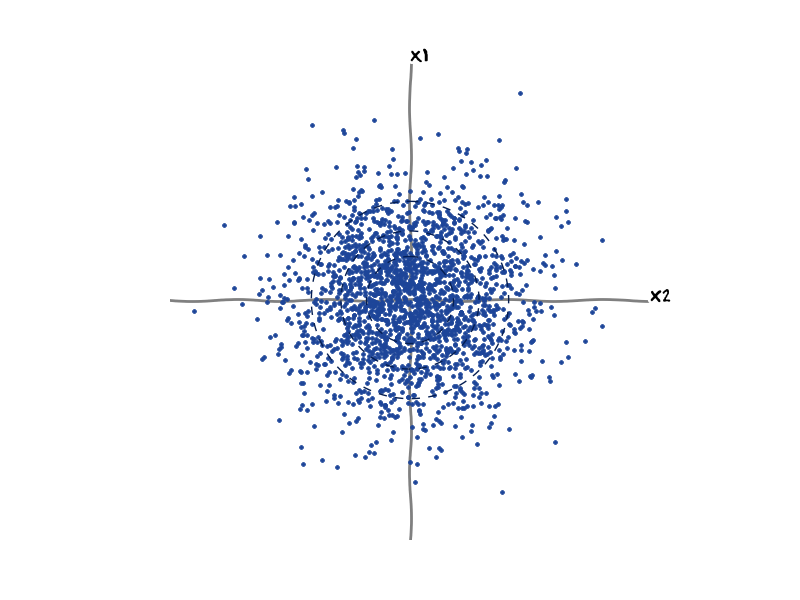I first argue for general identically distributed $X_1,X_2$ that the conditional mean of $Y_1$ conditional on $Y_2$ is constant $0$. Based on this, I argue that the covariance of $Y_1,Y_2$ is 0. Then, under normality, zero covariance implies independence.
The conditional mean
Intuition: $X_1+X_2=y$ does not imply anything about which component contributed more to the sum (e.g., $X_1=x, X_2 = y-x$ is as likely as $X_1 = y-x, X_2=x$). Thus, the expected difference must be 0.
Proof: $X_1$ and $X_2$ have identical distribution and $X_1+X_2$ is symmetric with respect to the indexing. Thus, for symmetry reasons, the conditional distribution $X_1 \mid Y_2 = y$ must be equal to the conditional distribution $X_2 \mid Y_2 = y$. Hence, the conditional distributions also have the same mean, and
\begin{equation}
\mathbb{E}(Y_1 \mid Y_2 = y) = \mathbb{E}(X_1 - X_2 \mid X_1+X_2 = y) \\ = \mathbb{E}(X_1 \mid X_1+X_2 = y) - \mathbb{E}(X_2 \mid X_1+X_2 = y)= 0.
\end{equation}
(Caveat: I did not consider the possibility that the conditional mean might not exist.)
Constant conditional mean implies zero correlation/covariance
Intuition: correlation measures how much $Y_1$ tends to increase when $Y_2$ increases. If observing $Y_2$ never changes our mean of $Y_1$, $Y_1$ and $Y_2$ are uncorrelated.
Proof: By definition, covariance is
\begin{equation}
Cov(Y_1,Y_2) = \mathbb{E}\left[\left(Y_1 - \mathbb{E}(Y_1)\right)\left(Y_2 -\mathbb{E}(Y_2) \right)\right]
\end{equation}
to this expectation, we apply the law of iterated expectations: take the expectation of the conditional expectation conditional on $Y_2$:
\begin{equation}
= \mathbb{E}\left[\mathbb{E}\left[\left(Y_1 - \mathbb{E}(Y_1)\right)\left(Y_2 -\mathbb{E}(Y_2) \right) \mid Y_2\right]\right] = \mathbb{E}\left[(Y_2 - \mathbb{E}(Y_2))\mathbb{E}\left[Y_1 - \mathbb{E}(Y_1) \mid Y_2\right] \right].
\end{equation}
Recall that the conditional mean was shown to be independent of $Y_2$ and thus the expression simplifies as
\begin{equation}
= \mathbb{E}\left[(Y_2 - \mathbb{E}(Y_2))\mathbb{E}\left[Y_1-\mathbb{E}(Y_1)\right]\right]
\end{equation}
but the inner expectation is $0$ and we get
\begin{equation}
= \mathbb{E}\left[(Y_2 - \mathbb{E}(Y_2))\times0\right] = 0.
\end{equation}
Independence
Just by assuming identical distributions for $X_1,X_2$, it was shown that $Y_1$ and $Y_2$ are uncorrelated. When $X_1,X_2$ are jointly normal (for example, iid. normal as in the question), their linear combinations $Y_1,Y_2$ are also jointly normal and thus uncorrelatedness implies independence.

 Notice that the distribution is circulary symmetric.
Notice that the distribution is circulary symmetric. This new coordinate system has the same origin as the original one, and the axis are orthogonal. Due to the circulary symmetry, the variables are still independent in the new coordinate system.
This new coordinate system has the same origin as the original one, and the axis are orthogonal. Due to the circulary symmetry, the variables are still independent in the new coordinate system.